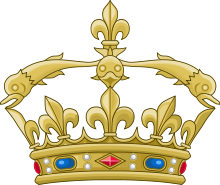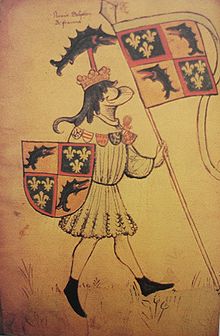Dauphin of France
Dauphin was the name of the respective heir to the throne of the King of France at the time of the Valois and Bourbon dynasties.
The title "Dauphin" (literally: "dolphin") goes back to the epithet of Count Guigues IV of Albon († 1142), who called himself le Dauphin. Among his descendants this epithet advanced to a title, the dolphin became their heraldic animal and finally gave the county of Albon in the Viennois the name "Dauphiné" (literally: "Delfinat"). In 1349, the childless Dauphin Humbert II. Since the Dauphiné de jure belonged to the Holy Roman Empire and King Philipp did not want to be a vassal of the Roman-German Emperor, he passed the principality along with the title Dauphin to his grandson and future heir to the throne, the later King Charles V., who then passed both on to his son, who then passed both on to his son, the later Charles VI. Thereafter, this practice became entrenched, and after the middle of the 15th century (the German emperors had in the meantime relinquished their claims to the Dauphiné), the respective French crown prince was called the Dauphin, or Dauphin de France (similar to how the English crown prince is traditionally called Prince of Wales or the Spanish crown prince Príncipe de Asturias).
Only descendants of the reigning king were entitled to the title, but not heirs to the throne who succeeded him as younger brothers or came to the throne from collateral lines of the ruling house. This is why, for example, the important kings Francis I or Henry IV were never Dauphins.
The last French crown prince to be officially called le Dauphin was Louis-Antoine de Bourbon, duc d'Angoulême (Louis XIX). He was the son of Charles X, who resigned and abdicated the throne after the July Revolution of 1830. However, the eldest son of each of the French pretenders to the throne from the House of Bourbon continued to hold the title, during the Second Empire and the Republics, as pretender to the throne.
Today's bearer of the pretender title Dauphin de France is Gaston Louis Antoine Marie d'Orléans (* 2009), eldest son of the pretender to the throne and head of the House of Orléans, Jean d'Orléans, Count of Paris (* 1965). The respective French pretender to the throne confers until today within his family ducal and count titles, which are described by today's French courts as mere courtesy titles, but are also used as such.
In contemporary French usage, the word "dauphin" is also used in another, more general meaning. It refers to the desired or designated successor of a higher official.
.png)
Crown of the Dauphin Louis Antoine worn in 1824 at the coronation of Charles X.

Heraldic representation of the crown of the Dauphins

The Dauphin and later French King Louis XI with dolphin as heraldic animal and crest, c. 1450 (Hyghalmen Scroll, Heralds' College Manuscript)
See also
- Dauphine, title of the wife of the Dauphin
- Dauphin of Viennois
- Dauphin of Auvergne
- List of the Dauphins of France
- Ad usum Delphini
Search within the encyclopedia